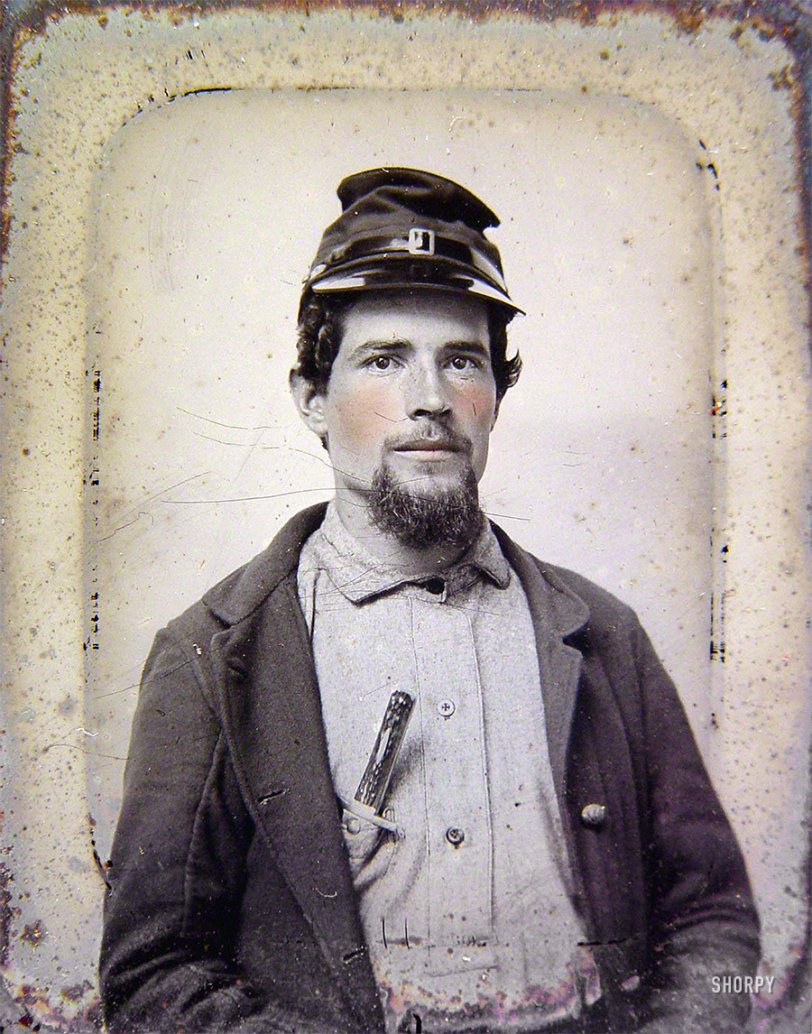


Framed or unframed, desk size to sofa size, printed by us in Arizona and Alabama since 2007. Explore now.
Shorpy is funded by you. Patreon contributors get an ad-free experience.
Learn more.

- Killed by Amtrak
- Back to the Future
- Heckuva remote control!
- Sometimes — Things Go Bump!
- I SEE THE LIGHT
- Union Switch and Signal Company
- Get That Light Out Of My Eyes
- Eggs. Eggs. Eggs. The Egg Man is Here!
- Foreboding caption
- Famous Hollywood faces
- Not just S&P
- re: Those things in the jar
- Up In Smoke
- Medical Smoking
- Quick fix
- A Quink Comment
- If You’re Like Me, Never
- Delivering the News
- U.S.A.
- S&P
- 1940 Zenith radio model 6G601
- Quality goes in before the name goes on!
- Snazzy skirt
- Carbon Arc Lamps
- Illuminate us
- I remember it well
- I can't prove it
- Complicated then, forgotten now
- Bryan-Stevenson
- Skinny is as skinny does
Print Emporium
Rusty: 1863

Ca. 1863. "Unidentified soldier in Union uniform with forage cap carrying a bone handle knife in breast pocket." Sixth-plate tintype, hand-colored. Liljenquist Family Collection of Civil War Photographs, Library of Congress. View full size.
Sheffield Bowie knife
The young man's knife looks a lot like this one.

Handle material
The knife has a stag handle fitted, rather than bone, in my opinion.
Very trendy
Rusty's goatee is very trendy today. You wouldn't be surprised to see it on a fedora-wearing, PBR-drinking hipster.
Deer stag handle.
The handle on this knife is deer stag, otherwise known as deer antler. They rarely used bone on these fixed blade or straight knives during this era because bone would break too easily. If bone were used, it was cow shin bone and often only used on folding knives. You can easily tell by the picture this is deer stag.
This knife also has what appears to be a nickel silver inlaid emblem. Which usually means it was made by a company rather than a custom maker. All a person would need to do is do some research and see what companies used this shape of a shield. They rarely changed shapes of shields from one knife to another.
When they did use bone, it was most often on a folding knife carried in a pocket. Often they used shin bone from a cow. Deer stag is as tough a handle material as you can ever find even to this day. It will last for hundreds of years without cracking or shrinking if kept in a stable environment.
To use an example of toughness in both, if you dropped a knife with handles made of cow bone on rocks, it would most likely shatter or break or cause cracks.
Deer stag can be dropped often, with almost never a break or crack. And lots of knives used during this era were used as hammers and had a lot of rough treatment.
Bone would not last for this kind of use unless it was on a small folder and kept in a pocket protected. Not saying they never used bone, but if they did, they were most likely replacing it often with deer stag or even most hardwoods were tougher than bone was and is to this day for knives.
Unidentified, maybe
but I know him better through this image than if I had a name, and no photograph. If I could meet him, I believe we would be friends.
Kinda looks like
a photo from one of those "old photo" galleries. Rusty's face looks practically brand new.
























On Shorpy:
Today’s Top 5